Blacktip Reef Shark
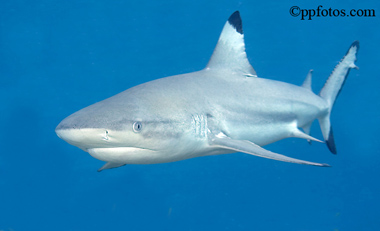
Carcharhinus melanopterus
A small-medium sized shark with recognizable black fin tips with white highlights. Blacktip reef sharks are abundant on coral reefs, making them a popular species in reef and dive tourism. They are also frequently displayed in aquaria.
Order – Carcharhiniformes
Family – Carcharhinidae
Genus – Carcharhinus
Species – melanopterus
Common Names
English language common names for this species include blacktip reef shark, black fin reef shark, black finned shark, blackfin reef shark, blacktip shark, reef blacktip shark. Other common names include cá mâp vây den, (Vietnamese), chalarm hoo-dum (Thai), requin à pointes noires, requin noir and requin pointes noires (French), swartvin-rifhaai (Afrikaans), tiburón de puntas negras (Spanish), tsuma guro and tsumaguro (Japanese).
Importance to Humans
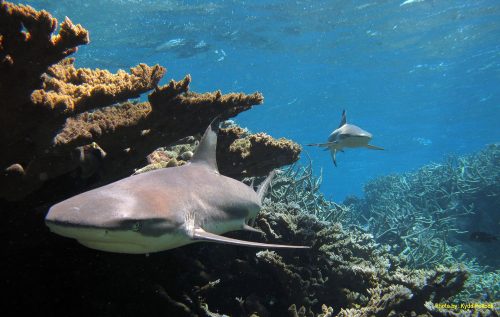
Blacktip reef shark are caught by inshore fisheries throughout some parts of their distribution. They are utilized for fins, meat and liver oil but have limited commercial value due to their small size. Blacktip reef shark are important in aquaria and for dive tourism.
Danger to Humans
Blacktip reef shark have occasionally been known to bite people that are swimming or wading but do not pose a serious threat to humans. The International Shark Attack File (ISAF) has recorded just 11 unprovoked blacktip reef shark bites on humans since 1959.
View shark attacks by species on a world mapConservation
IUCN Red List Status: Near Threatened
Blacktip reef shark are considered “Near Threatened” according to the International Union for the Conservation of Nature (IUCN) threatened species criteria. Population bottlenecks have been reported in some regions (Vignaud et al. 2014) but may not be an accurate reflection of overall population trends (Maisano-Delser et al. 2017, Maisano-Delser et al. submitted). They are known to be locally abundant in other parts of their range. Though not considered to be at immediate risk of population depletion, the species is vulnerable to negative impacts of fishing pressure and habitat destruction.
> Check the status of the blacktip reef shark at the IUCN website.
The IUCN is a global union of states, governmental agencies, and non-governmental organizations in a partnership that assesses the conservation status of species.
Geographical Distribution
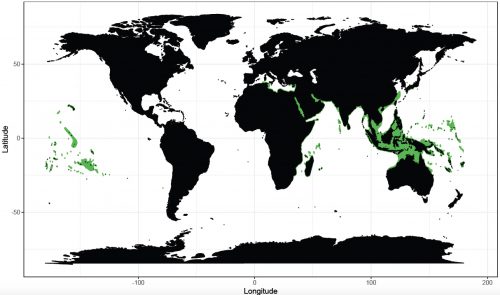
The blacktip reef shark is commonly found throughout the tropical Indo-Pacific. Their range includes waters surrounding Thailand, China, Japan, the Philippines, Indonesia, Malaysia, Papua New Guinea, New Caledonia and northern Australia (Compagno 1984). Blacktip reef shark are one of the most common reef sharks at islands in the Pacific Ocean, as far east as the Hawaiian Islands. The species is also present in South Africa, Mauritius, Seychelles, Madagascar, the Red Sea, Pakistan, India, Sri Lanka and the Maldives (Compagno 1984, Ebert et al. 2013). Reports from the Mediterranean Sea are anecdotal, there are no known established populations.
Habitat
Prefers shallow, clear water. Commonly found on coral reefs, reef and sand flats, over reef drop offs, in atolls or along continental and insular shelves, including tidal movements into mangrove environments (Last and Stevens 2009, Ebert et al. 2013). Blacktip reef sharks have small home ranges, exhibiting strong site fidelity and restricted movements that appear to be closely tied to the distribution of coral reef habitat (Papastamatiou et al. 2010, Papastamatiou et al. 2009, Stevens 1984). Long distance movements over oceanic expanses appear uncommon. The average daily activity space of this species was estimated to be ~10 km2 (Mourier et al. 2012). Individuals spend ~70% of their time within an area 0.3 km2 over the course of a year and migrations are usually around the same island or between neighboring islands (Mourier and Planes 2013).
Biology
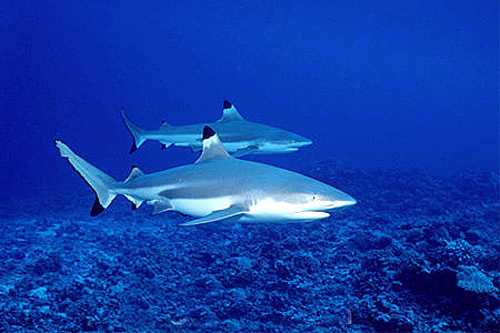
Distinctive Features
Medium sized body with a snout that is short and bluntly rounded. Eyes are horizontally oval and the cusps of the teeth are narrow. Lacking an interdorsal ridge and the second dorsal fin is large with a short rear tip. The first dorsal fin originates over the free tips of the pectoral fins.
The grey reef shark (Carcharhinus amblyrhynchos) may be confused with the blacktip reef shark, however the grey reef shark can be distinguished by its stockier body and lack of black tip on the dorsal fin. The prominent black tips on all fins distinguishes this species from others that it may otherwise be easily confused.
Coloration
Blacktip reef shark are a brown-tan color on the dorsal surface with white countershading on the underside. A light band extends along the flank from the anal fin to just above the pectoral fins as in many species of the genus Carcharhinus. All fins are black-tipped accentuated by white pigment closer to the body of the shark.
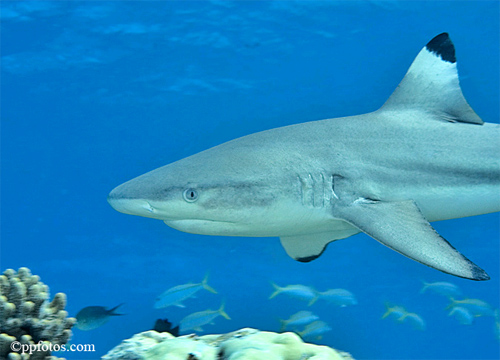
Dentition
The blacktip reef shark has narrow, serrated upper teeth with an erect to oblique cusp and cusplets. The lower teeth are also narrow with finely serrated edges. Tooth counts range from 23-28 in the upper jaw and 21-27 in the lower jaw (Compagno 1984).
Size, Age, and Growth
There is regional variation in size at birth, size at maturity and maximum size. Maximum size is generally less than 160 cm (5.2 ft) though individuals have been recorded up to 180 cm (5.9 ft). They are born at 33-59 cm (1-2 ft). Males mature between 91-100 cm (3-3.3 ft) and females between 96-112 cm (3.1-3.7 ft; Stevens 1984, Lyle 1987, Papastamatiou et al. 2009a, 2009b, Mourier et al. 2013, Chin et al. 2013, Ebert et al. 2013)
Denticles
The denticles (placoid scales) of the blacktip reef shark are tooth-like in structure and embedded firmly in the skin.
Food Habits
Blacktip reef sharks prey on teleost fishes, crustaceans, cephalopods and other molluscs (Stevens 1984, Lyle 1987, Last and Stevens 2009). Interestingly, the species is also reported to have consumed terrestrial and sea snakes (Lyle 1987, Lyle and Timms 1987).
Reproduction
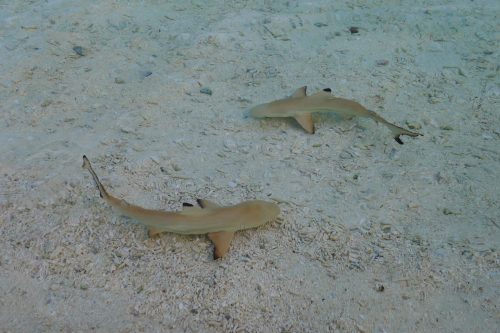
Blacktip reef sharks are live-bearing, nourishing pups in utero via a yolk-sac placenta. Both annual and biennial reproductive cycles have been reported across various parts of the range. Parturition and mating generally occur during the summer and early autumn though gestation also varies with location from 8-9 months, 10-11 months, and 16 months. Most litters contain 2-4 pups (Lyle 1987, Porcher 2005, White 2007, Mourier et al. 2013, Johnson 1978, Stevens 1984)
Parasites
A recent study of one captive blacktip reef shark reported histozoic skeletal muscle myxosporeans. Anthobothrium lesteri have also been found in the intestinal tract of the blacktip reef shark.
Taxonomy
Quoy and Gaimard first described Carcharhinus melanopterus in 1824. Synonyms include Squalus carcharias minor Forsskål 1775, Carcharias playfairi Günther 1870 and Carcharias marianensis Engelhardt 1912.
References
Chin, A, Simpfendorfer, C, Tobin, A and Heupel, M (2013) Validated age, growth and reproductive biology of Carcharhinus melanopterus, a widely distributed and exploited reef shark. Marine and Freshwater Research 64: 965–975.
Compagno, L.J.V. 1984. Sharks of the World. An annotated and illustrated catalogue of shark species to date. Part II (Carcharhiniformes). FAO Fisheries Synopsis, FAO, Rome.
Ebert, D., S. Fowler, and L. Compagno. 2013. Sharks of the World. Wild Nature Press, Maurice, Plymouth.
Johnson R.H. (1978). ‘Sharks of Tropical and Temperate Seas (with a Key to the Identification of Polynesian Species and a Detailed Discussion of Species Occurring in French Polynesia).’ (Les Editions du Pacifique: Papeete, Tahiti.)
Last, P.R. and Stevens, J.D. 2009. Sharks and Rays of Australia, 2nd edition. CSIRO, Melbourne, Australia.
Lyle, J.M. 1987. Observations of the biology of Carcharhinus acutus (Whitley), C. melanopterus (Quoy and Gaimard) and C. fitzroyensis (Whitley) from Northern Australia. Australian Journal of Marine and Freshwater Research 38: 701–710.
Lyle, J.M. and Timms, G.J. 1987. Predation on aquatic snakes by sharks from Northern Australia. Copeia 1987: 802–803.
Maisano Delser, P., S. Corrigan, M. Hale, C. Li, M. Veuille, S. Planes, G. Naylor, and S. Mona. 2016. Population genomics of C. melanopterus using target gene capture data: demographic inferences and conservation perspectives. Scientific Reports 6: 33753.
Mourier, J., Mills, S. C., and Planes, S. (2013). Population structure, spatial distribution and life-history traits of blacktip reef sharks Carcharhinus melanopterus. Journal of Fish Biology 82: 979–993.
Mourier J, Planes S (2013). Direct genetic evidence for reproductive philopatry and associated fine-scale migrations in female blacktip reef sharks (Carcharhinus melanopterus) in French Polynesia. Molecular Ecology 22: 201-214
Mourier J, Vercelloni J, Planes S (2012). Evidence of social communities in a spatially structured network of a free-ranging shark species. Animal Behaviour 83: 389–401
Papastamatiou, Y. P., Caselle, J. E., Friedlander, A. M., and Lowe, C. G. (2009a). Distribution, size frequency, and sex ratios of blacktip reef sharks Carcharhinus melanopterus at Palmyra Atoll: a predator dominated ecosystem. Journal of Fish Biology 75: 647–654.
Papastamatiou, Y. P., Lowe, C. G., Caselle, J. E., and Friedlander, A. M. (2009b). Scale-dependent effects of habitat on movements and path structure of reef sharks at a predator-dominated atoll. Ecology 90: 996–1008
Porcher, I.F. (2005). On the gestation period of the blackfin reef shark, Carcharhinus melanopterus, in waters off Moorea, French Polynesia. Marine Biology 146: 1207–1211
Stevens, J. D. (1984). Life-history and ecology of sharks at Aldabra Atoll, Indian Ocean. Proceedings of the Royal Society of London. Series B, Biological Sciences 222: 79–106
Vignaud, T. M., J. Mourier, J. A. Maynard, R. Leblois, J. Spaet, E. Clua, V. Neglia, and S. Planes. 2014. Blacktip reef sharks, Carcharhinus melanopterus, have high genetic structure and varying demographic histories in their Indo-Pacific range. Molecular Ecology 23: 5193–5207.
White, W.T. (2007). Catch composition and reproductive biology of whaler sharks (Carcharhiniformes: Carcharhinidae) caught by fisheries in Indonesia. Journal of Fish Biology 71: 1512–1540.
Revised by Shannon Corrigan and Gavin Naylor 2018
Original preparation by Michelle Press